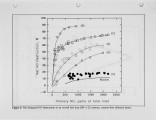| OCR Text |
Show which does not. It is clear from Figs. 5 and 6 that the data show more NO destruction than was predicted by the 1-D model, which is depicted by the solid line next to data labelled E. The importance of edge effects was explored by doping NO so as to allow it to bypass the flat stretched portion of the flame, and to contact the reaction zone only in the non one-dimensional sheared co-flowing regime (Configuration D). The difference between NO exhaust levels from Configurations A and D should approximate the net effect of the central, flat flame, which is the portion that can be theoretically calculated. This difference is small, and much of the NO reduction (in excess of 40%), occurs in the co-flowing portion of the diffusion flame, not in the stretched flat flame. Note, also, that Configuration B, and to a lesser extent Configuration C, are also non one-dimensional within the flat flame, as far as NO concentrations only, are concerned. Therefore, the greater destruction of NO in a diffusion flame is observed when NO is allowed to exploit its fuel rich regions in a co-flowing, rather than in a counter-flowing manner. It is the non one dimensional nature of how NO contacts the diffusion flame, by travelling alongside it, that allows the observed destruction to take place, and this non onedimensionality cannot be accounted for in a I-D model. The model, in fact, simulates Configuration E, in which all reactions outside the flat stretched portion of the diffusion flame are quenched, by a nitrogen shield. Net NO destruction results for Configuration E are not nearly as interesting as those observed for Configurations A through D. However, there-is now excellent agreement between modeling and experimentally measured results. Therefore, a truly one-dimensional, overall fuel lean, stretched flat diffusion flame will not destroy much NO, and a co-flowing configuration is criti~al to achieve significant NO reduction in overall fuel lean laminar diffusion flames. Temperature, Major and Minor Species Profiles A more severe comparison between model and data can be made by comparing predictions and measurements of axial profiles of species and temperature, rather than by comparing those describing integrated exhaust results only. To ensure that the agreement between model simulations and integral data is not fortuitous, this comparison was accomplished with no adjustment of kinetic, thermodynamic or transport parameters being made in the model. Results are shown on Figs. 7 through 9. In all cases, the fuel side is on the left, which corresponds to the upper burner. The measured flame temperature profile of the flat diffusion flame, with annular quench gas (Configuration E), was well predicted by the model (Fig. 5, upper). The location of flame zone was accurately predicted, and the peak flame temperature was predicted within 69 K. The small discrepancy immediately on the fuel rich side of the flame might be a measurement artifact due to the uncoated thermocouple. For most stable species (02, CH., and CO2 ), modeling results agreed well witQ measured data (Fig. 7, lower). Good agreement was also achieved for H2, while there was a slight discrepancy between measured and predicted values of the peak CO concentration (3.5% vs 5.3%). C2~ and C2H. concentrations were well predicted by the model with Miller and Bowman kinetics[II]. The greatest discrepancy (factor of 2) occurred in the C2H2 profile. Possibly the |




















